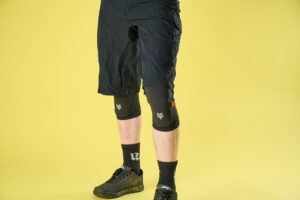As an alternative to a GoPro for mountain biking POV clips, the Insta360 Go 2 has a lot to like.
Insta360 Go 2 action camera review
Traditionally, the go to product for mountain bikers looking for the best action camera has been the GoPro. But Insta360 has been chipping away at the GoPro faithful recently thanks to its innovative range of products, one of those being the minimal Go 2.
Controversially, with its compact dimensions, light weight and unobtrusive mount, I actually believe it’s a better solution for most riders than a GoPro, but a few issues hold it back from perfection. Here’s why.
Design
To begin with, let’s go through the basics. Insta360 sells the Go 2 in two different storage capacities (32GB and 64GB) and various bundles with different accessories depending on what activity you’re doing. The kit tested here is the basic ‘Standalone’ option, which confusingly comes with quite a few extras. You get the camera module – which is not much bigger or heavier than an AA battery – a smooth, pebble-shaped charging/carry case, a clip mount, a pendant mount, a pivot stand, a rubber case and a USB C charging cable. Magnets keep the camera firmly attached to the various mounts as well as held in the charging case – which bears a remarkable resemblance to Apple’s AirPod case. Insta360 does offer a specific Bike Kit with a chest mount and bar mount for an extra £50, but the standalone kit includes enough to get most riders up and running.
One of the very best aspects of the Go 2 is its size. It’s tiny compared to a GoPro, and it can be attached and detached in just a couple of seconds with no need to faff around with screws thanks to those magnets. The clip mount is so small and light that you can leave it installed onto the peak of your helmet permanently, and you can snap the camera in at the top of a descent and take it off to store back in its charging case at the bottom. The charging case is small and light enough to slip into a pocket and also includes a tripod mount and clever fold out legs to turn it into a stand for capturing self-shot action.

The Insta 360 Go 2 camera unit fits into this compact charging case when not in use. Small and light, it’s easy to carry in a pocket and removes in seconds.
Performance
The beauty of this convenience and minimalism is that, compared to using a GoPro, I found myself being much more spontaneous with the Insta360 Go 2. It takes up less space, so I started bringing it with me on more rides. Rather than going out with the sole intent of shooting some clips, the Go 2 inspired me to whip it out and start filming on impulse, and I really liked that aspect of it.
Controlling the camera can be done via the charging case or a smartphone app. Obviously the app gives the most control, and allows you to view your clips, but requires connecting the two devices using WiFi/Bluetooth, which is a little time-consuming while on a ride. The most convenient way then, is to use the case. There are only two buttons and a small display screen to worry about – one changes the mode (video/pro video/photo/timeshift/time lapse/slow-motion/HDR) and the other starts and stops the recording. A series of haptic buzzes let you know when recording has started and stopped. You can also press the front of the camera unit to start and stop recording on a long descent when you don’t want to take the charging case out of your pocket. Again, there are buzzes at the start and finish of every clip for peace of mind.
Resolution on the Go 2 tops out at 2560×1440 at a maximum of 50 frames per second. Most of the time I stuck to 30fps to smooth out the footage on wooded trails, where there’s a lot of detail to capture and this worked well. The camera copes well in most conditions, producing crisp, incredibly smooth footage that feels like it was shot by a drone or a steadicam. In fact it’s so well stabilised that you can feel somewhat disconnected from the footage as a viewer if there’s no rider in front. For solo riding I’d suggest running the chesty cam mount, but for following a mate, the camera placed under a visor gives a fantastic viewpoint. There may not be a screen to check the angle, but it’s pretty easy to get it right by eye, and if you want to be sure, you can always connect the camera to your phone. Because you can leave the mount attached to your helmet, you only need to do this set-up process once.

The carry case has fold out legs so that it can be used without a tripod. The two buttons give control over the mode, settings and allow you to use the carry case as a remote control.
Head into the app and you can do a lot, from editing exposure, white balance, contrast etc, to adding filters, changing the speed, adding music and (in Pro Video) altering the field of view and cropping the footage into an Instagram-friendly vertical format as well. In low-light conditions the footage does get grainy and a bit shaky, but it’s far from unwatchable.
For such a small unit, battery life expectations have to be kept realistic. With the camera disconnected from its case, Insta360 claims around 30 minutes life. But, because you can pop the camera back in its case between descents, in the real world I’d get over an hour out before the whole thing needed charging. This works perfectly for most mountain bikers shooting trails that are perhaps five minutes or so in length. But if you’re looking to capture a big day in the mountains, with no access to power, a GoPro and a couple of back-up batteries will be a better option.
At the start of the review I said that a few issues prevent the Insta360 Go 2 from getting top marks. The main one being that the clip mount snapped when putting it onto a visor for the photo shoot – hardly surprising since there’s no mechanical hinge, and the clip relies solely on the flex of the plastic. I’d like to see Insta360 improve this area to make it more robust – a sprung mechanical hinge would do the trick. It’s also worth noting that the clip won’t work on visors with a ridge or a curve, such as the Troy Lee Designs A3.
The other issue is wind noise, which is overbearing at most trail speeds even with the wind noise reduction activated. Of course you can reduce the volume, or add music, but for recording ambient sounds while riding, the Insta360 Go 2 isn’t great.
Verdict
On balance the Insta360 is a very worthy alternative to a GoPro. It excels as a neat, unobtrusive, portable option for grabbing clips on a routine ride, as you can be up and running in seconds, even if you didn’t plan on shooting any POV footage. Using it doesn’t interrupt the flow of a ride but it does a great job of capturing the moment. With a better visor mount and improved microphone I’d probably give it top marks.
















